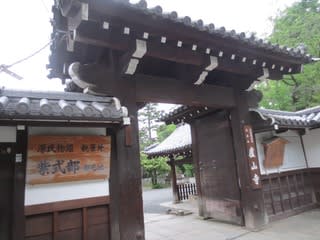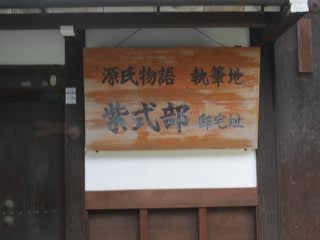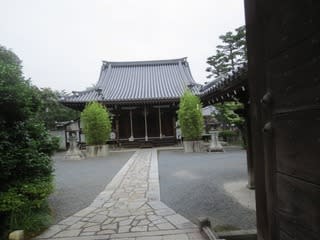
(源氏物語執筆地、紫式部の館が寺社になっています!)
Gender Politics and Ethnicity in Okinawan Theatre, with a Special Focus on Female Performers
--- Soon afterOkinawa(ns) met the U.S occupying forces, traditional theatre stepped into a new sphere in which female performers became visible---
S. Yonaha
Introduction:
It was certain that a great change was brought in the performing arts in Okinawa, though it appeared to be a nightmare that so many Okinawan civilians were killed on the battlefield of Okinawaduring the Asia Pacific War from April 1st to June 23rd 1945.
WhenOkinawa(ns) met the West, actually the U.S occupying forces, the total sphere of performing arts changed in the refugee camps. TheUScivil affairs office tried to comfort a lot of war devastated Okinawan refugees in the camps while the battle was still going on. Those US officers asked many Ryukyu dance and theatre professionals to entertain people. Among them were female performers who used to be Geigi (a geisha-like role) at the Tsuji pleasure quarters: Eiko Uehara (1915-1990) and Ikuko Uema (1906-1991). Both were well known dancers around Tsuji, and only girls there were able to appear on the stage.
In the refugee camps, experiencing the tragic trauma from the land battle on their very own homeland, observing the defeat of Japanese forces under the immensity ofUSpower, they had no other choice but to obey a new ruler as well as the savior of their lives.
It was at this time that entire previous beliefs and conventions were more or less changed. In a sense traditional Okinawan men and women’s roles were obliged to be changed by the new idea of American democracy. A specific example of this change was brought to the female dancers and singers in the Tsuji pleasure quarter. They were asked to dance in front of the common people, were well appreciated, and provided with some reward from the civil affairs officers. Mainly it was food.
In this paper, first, I’ll examine the USpolicy toward the cultural politics on Okinawa through the CIVIL AFFAIRS HANDBOOK Ryukyu (Loochoo) Island. What sort of information about Okinawa(ns) was provided to the US forces officials is overlooked in this handbook. It gives the background resources, why the American Navy’s military government officer, Captain Willard A. Hannah (1911-1993) made it possible to construct the Higashionna village museum and why he formed the Okinawan Performing Arts Federation soon after Japan declared its complete surrender to the world (acceptance of the Potsdam Declaration) on August 15th. Accordingly, the Okinawa Advisory Council was started with 15 representatives from 39 refugee camps. Captain Hannah said that it was necessary to ease the war-devastated people’s minds, therefore, theUS military government planned to revitalize Okinawan performing arts as their cultural politics, so, many actors, musicians, and dancers were gathered atCamp Ishikawa, and eventually the Okinawan Performing Arts Federation was founded. They organized Okinawa dancing teams and started to present and perform at those 39 camps and also at US military stations.
Second, as specific examples of US gender politics, I will illustrate two women’s cases after the war, those of Eiko Uehara and Ikuko Uema. Eiko is well known as a model for the novel The Teahouse of the August Moon, and Ikuko is a distinguished woman who became the director of an all-female theatre company OTOHIME.
Third, what the US forces actually did soon after or during the battle on Okinawa toward Okinawan performing arts and artists demonstrates that they tried to make Okinawans dis-assimilate from Japan. Okinawan ethnicity was emphasized as the politics of occupation that theUSwas willing to colonize Okinawa for its own benefit to expand their influence of democracy as well as military bases leading to further expansion inAsia.
Encountering the West (actually theUSforces and its military occupation government) the Okinawan traditional performing arts and artists repossessed what they had achieved before the war. Further, it was reconstructed facing the new post-World War II circumstances under the new authority which was eager to promote the American way of thinking, Christianity, and American style democracy. For not only female performers (mostly juri, or geigi) but also the general public, gender politics became visible. From the refugee camps, Okinawan female performing dancers and singers started to have their own ownership of being performers.
以下省略:
1.
2.
3.
Conclusion
********************************
以上は明日の研究発表パネルの原稿です。アジア演劇が西洋をどう受容したか、が大きな問で沖縄演劇がどう西洋と向き合ったのか、考えてみました。
発表原稿は5000語と多いのですが、これは今から注釈、参考文献をつけて論文として提出する予定です。7000語くらいにまとめたい。
7月末にイギリスの国際学会ではgender Stratificationのテーマで近世から近代における沖縄の芸能・演劇について論文をまとめて発表する予定です。京都の初夏、雀たちが窓でさえずる声が聞こえてきたのはいいね!

(源氏物語、執筆地です!あやかりたいですね!)

(住職さんのお話しを少しお聞きしました。謝!)
世界で初めての女性作家がこの地で『源氏物語』を執筆した、というそれだけで
思いが深くなります!物語を書きたいという気持ちにさせます。生きている間、想いを
形にしたいものです。



















